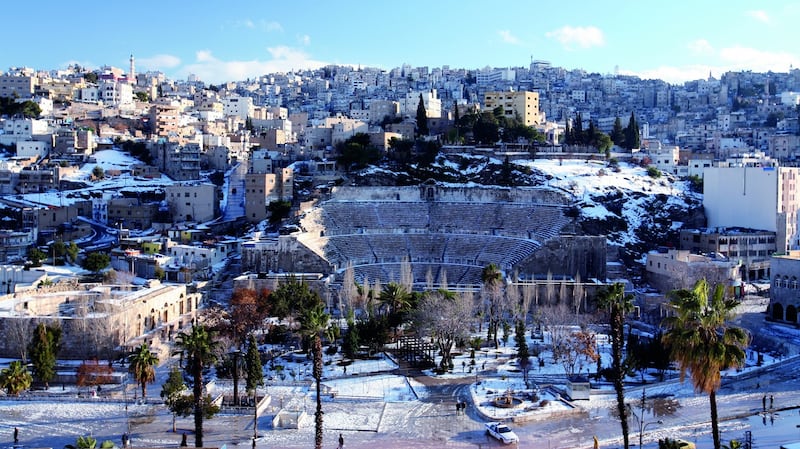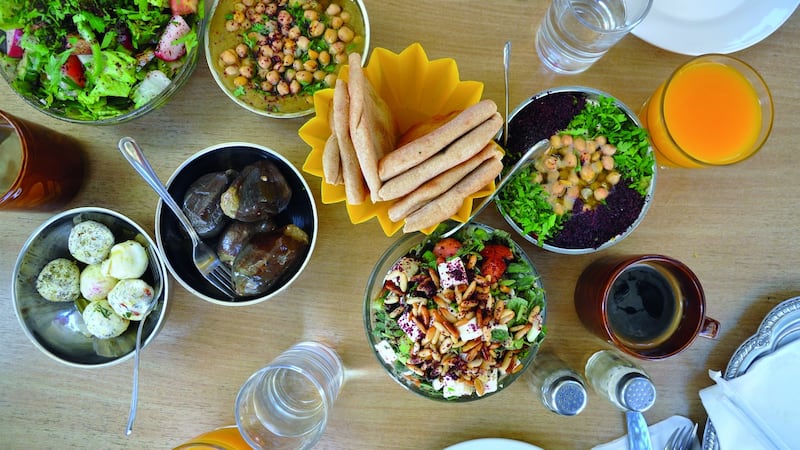In early October, I travelled to Jordan to visit my sister and experience the spectacular food the region is known for. We flew from Cork early in the morning, with a brief stopover in London, then made it to Jordan by midnight.
The air was warm, with Jordanian flags swaying in the night breeze. It felt calm and quiet, as though we were the only ones awake.
Neighbouring Syria has been a war zone since 2011. More than seven million people have been forced to flee their homeland, with a staggering 480,000 casualties reported.
Most Jordanians have perfect English, especially in urban areas such as Amman. Jordan only gained independence from the UK in 1946. Our taxi driver told us his family had originated in Damascus. When there were no borders, his father travelled to Jordan and decided to settle there. There was fluid movement between the two countries, with day trips at the weekends and families often spread across both Syria and Jordan. Syria was advanced and cultured, with much to offer holiday-makers. The Jordanians we spoke to were clearly heartbroken for their neighbours. The UN Refugee Agency's latest figures record more than 650,000 Syrian refugees in Jordanian camps. Syria itself has taken in millions of refugees over the years, including, most recently, three million displaced Iraqis in 2003.
Jordan too has always had a tradition of being gracious and hospitable - as a group of six women travelling together, we found Jordan to be welcoming and very safe. We were there to experience all of the historic and culinary delights of this wonderful country and it did not disappoint.

On our first day we headed straight for Shams El Balad, a farm-to-table cafe in the heart of Amman. They host yoga classes, supper clubs and workshops in a beautiful 1940s building. We sat on the terrace in dappled shade and ate soft sheep's milk labneh like none I've tasted before.
The mutabbal was creamy and rich, a charred aubergine dip quite like baba ghanoush. A fresh zaatar salad was exquisite, with intense fresh oregano, tomato, pine nuts and Palestinian akkawi cheese. The hummus was served with a blanket of punchy sumac, not like the pinch I would sprinkle on my own at home.
We had delicious potato mfarakeh, a type of soft scrambled egg. It was my first time coming across makdous, preserved baby aubergines that are stuffed with a mixture of walnuts, garlic and chilli flakes then submerged in olive oil and left for at least five days before eating. They can be preserved this way in olive oil for up to a year.
The drinks menu was equally evocative, with beautiful watermelon and rose juice, homemade cherry lemonade and sesame date smoothies.
After strong Turkish coffees, we set off for Petra, with a fascinating stop-off at Shoubak Castle. It was built in 1115 and has prime position on top of the hillside, over a natural spring still accessible by more than 350 steep, slippery stone steps.
Our local guide was a fountain of information and spoke eloquently of the battles and history of the area. We drank honey-sweetened sage tea outside and bought camel bone necklaces from the Bedouin merchant.
Petra is hidden in the mountains, one of the New 7 Wonders of the World and a Unesco World Heritage Site. That night, we left our hotel just as dusk fell to experience Petra by night. Hundreds of candles are lit along the path to the main Treasury. It's a beautiful awe-inspiring trek and each crevice and red rock carving is lit by the warm glow of candlelight. The caves, hollowed out by the Nebataean people in the fifth century, are gently illuminated by the flickering flames and everyone speaks in hushed tones.
The path led us to the main temple where we all sat on the sand and listened to traditional music before multi-coloured electric lights spread across the Treasury like a misplaced aurora borealis. It was a multi-sensorial experience, the smells of the camels were offset by the sweet cinnamon tea we drank.
After an early-morning hike around Petra, we drove to Madaba, the home of St George's Church. There we saw the oldest map of Palestine, a beautiful Byzantine mosaic created in AD 560. It originally had more than two million pieces, much of which has been lost but it is still wondrous to see.
The Franciscan Order became custodians of the site in 1932 and have excavated the fourth-century church and restored it sympathetically, including many local mosaics that would have otherwise been lost or stolen. Animals, battles, food and scenes from everyday life are depicted in the fascinating mosaics.
At the Dead Sea, we floated in the briny waters and covered ourselves in the mineral-rich mud. Definitely not to be missed.

My highlight that night was our dinner of the traditional lamb and rice dish mansaf and the incredibly indulgent um ali, a bread-and-butter pudding made with puff pastry or palmiers, cream, raisins and plenty of cinnamon.
The next day we toured Jerash, an ancient Roman city including Hadrian’s Arch, a hippodrome that hosted chariot races and the Temple of Zeus, built around 162. We walked along “shop street”, which would have been lined with market stalls and saw intricate mosaics crumbling on the ground due to the daily footfall. Yet the site needs more tourists to visit in order to fund its restoration works.
Most of this ancient site has been buried under rubble since a devastating earthquake of 749, but French archaeologists, in particular, have been carrying out restoration works since the 1920s.
On our last day, we took a much-anticipated cookery course at Beit Sitti, a wonderful cookery school run by three sisters in their grandmother’s house in one of Amman’s oldest neighbourhoods. Local women teach traditional recipes such as tabbouleh, fattoush and moutabbal.
I highly recommend this as we learned so much that afternoon and asked so many questions.
The food we made was delicious yet so simple. Passing on recipes and cooking together is such a gift and the love of delicious food is universal. The few days I spent in Jordan was supposed to be a once-in-a-lifetime trip, but already I’m planning my return.
HOW TO – JORDAN
ATMs will accept regular debit cards and there are usually debit card facilities available
The currency is the Jordanian dinar.
Jordan is a year-round destination but best times to visit are early spring before it becomes too hot and autumn, when temperatures drop and the first rains refresh the dry land.
Upon arrival, you will need to buy a visa at the airport, payable by laser card and less than €50.
Jordan Select Tours, tour operators where we sourced our fantastic driver Wael. www.select.jo
Movenpick Hotel in Petra, ideally located across the road from entrance to Petra.
Movenpick Hotel at the Dead Sea, has a path down to a bathing area, complete with showers www.movenpick.com
Beit Sitti Authentic Arabic Cooking www.beitsitti.com
Shams El Balad for breakfast and lunch https://www.shamsamman.com/
Buy a Jordan Pass, save money and see all of the sites www.jordanpass.jo
Get a local guide once you arrive on site, they don’t cost much and are incredibly knowledgeable. Don’t forget to tip as you might be the only customer they have that day.












